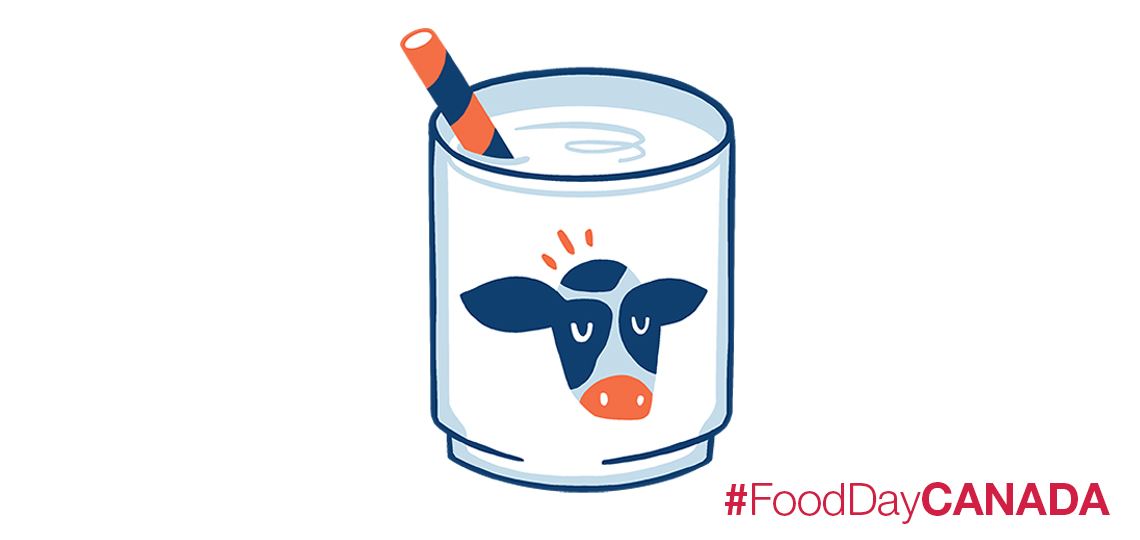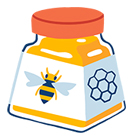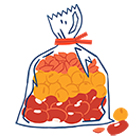Milk: a versatile Canadian ingredient

We’re celebrating Food Day Canada this year by sharing information, recipes and fun facts for the whole family. Many of our alumni and community are balancing working from home and childcare, so we thought we’d share some fun activities to entertain everyone.
Food Day Canada is a great opportunity to enjoy food, make food and learn about food.
Nutritional Highlights of Milk
A cup of 2% cow’s milk contains 15 nutrients that are essential for health, including calcium (302 mg), vitamin D (2.8 mcg) and protein (9g). Here’s more on these important nutrients and their effects on our bodies:
- Protein in necessary for the body’s growth and development, repairing body cells and bone health. Milk is considered a “complete protein” because it contains all nine essential amino acids needed for the body’s vital functions!
- Milk fat is one of the most complex of all-natural fats. It contains about 400 different types of fatty acids, which help promote healthy brain function, support healthy skin and hair, and so much more!
- Milk is one of the best dietary sources of calcium. The calcium found in milk is also easily absorbed by the body. Calcium is an essential mineral needed to build strong bones. We lose calcium daily through our sweat, skin and hair, so it is important to get enough of it from our diet every day!
- Vitamin B12, potassium, calcium and vitamin D are a few important vitamins and minerals milk provides.
- Carbohydrates make up about 5% of milk. The carbs found in milk are mainly in the form of a simple sugar called lactose. Some people do not have the enzyme needed to break down lactose and this condition is called lactose intolerance.
Reflection activity: What are your favourite foods? Think deeply about all the different components and ingredients that go into your favourite meals and foods. Do any of them include milk or products made from milk?
A Milk Recipe to Try!
Milk and Cookies Popsicles are a simple and fun treat you can make at home. This recipe will satisfy your sweet tooth, provide a fun activity for the family and help you beat the summer heat. Check out the recipe for Milk and Cookies Popsicles here.
Before summer (and ice cream season) ends, try this No Churn Vanilla Ice Cream recipe. This homemade ice cream is smooth, delicious and pairs perfectly with fruit, cakes, pies or whatever you’d like! Check out the recipe for No Chrun Vanilla Ice Cream here.
Fun fact: The greatest amount of milk produced in one year was 59,298 pounds by a Holstein cow named Robthom Sue Paddy.
Reflection activity: Make one of the above recipes. What was the best part of making the recipe? What was the most challenging? Would you change the recipe for next time?
U of G Connection to Milk
There is a long history of dairy research at the University of Guelph and OAC. Today dairy research doesn’t just focus on milk production, but also animal health and welfare, genetics and genomics, food science and safety, human health and nutrition, economics, business, environmental sciences, computer sciences and engineering.
Dairy at Guelph is a group of researchers at the University of Guelph all focused on producing research that is connected to dairy production and products.
The University of Guelph is also home to one of Canada’s most significant dairy research facilities: the Ontario Dairy Research Centre at the Elora Research Station. Faculty, students and research staff use the facility and its resources to conduct research that benefits the dairy industry and consumers.
Fun fact: The Dairy at Guelph initiative includes 90 different researchers working on dairy related projects!
Milk Historical Note
Dairy farming started in Canada in the early 1600s, when French settlers brought in dairy cattle. At the time dairy products were provided to towns by local farmers. In 1850 the modern factory method of cheese making was introduced, and the first cheese factories were built in Canada in 1864 (Ontario) and 1865 (Quebec). Milk and dairy production have drastically changed over the years! Milk use to come in returnable glass containers and was delivered from door to door. Today most products come in plastic packaging and are found in grocery stores.
Nutrition surveys in the 1930s and 1940s revealed that many Canadians had calcium deficiencies. Children in lower income families were only consuming half the recommended amount of calcium for health development. In an effort to improve the health of Canadians, milk and dairy products were included in coordinated government actions in nutritional advising.
A process called pasteurization was invented by a Louis Pasteur, a French scientist. This process kills any microbes and germs that can be found in raw milk. Pasteurization was made mandatory across Canada in 1991 and today vitamin D is added to pasteurized milk to help our bodies better absorb its calcium. Today, the majority of dairy farms in Canada are located in Ontario and Quebec.
Fun fact: An average dairy cow weighs 1,200 pounds, that’s about 8,000 scoops of ice cream!
Reflection activity: Look at the dairy products in your fridge. Can you find this logo? Why do you think this logo is used? Why is it important?
Environmental Impact of Milk
The dairy industry is a contributor to greenhouse gas emissions. Greenhouse gases absorb the sun’s radiation and hold heat close to earth’s atmosphere. The emissions of livestock animals, such as dairy cows, are a gas called methane. Luckily, research is being conducted right here at the University of Guelph to reduce the impact. Some of the research includes changing the diets of dairy cows to lessen the emissions.
Another project is called the The Efficient Dairy Genome Project. This project is looking to find way to naturally breed dairy cattle with improved feed efficiency and lower methane emissions. These traits are not currently selected for in the dairy industry, and has real potential to decrease dairy’s impact on the environment. Want to learn more? Listen to Episode #9 of The Why and How Podcast: How can dairy genomics fight climate change?
Fun fact: Milk is a natural and pure product. The use of bovine growth hormones (rbST) is illegal in Canada. Nothing is added to milk except vitamins A and D.
 |
Learn more:
|
 |
Learn more:
|
 |
Learn more:
|